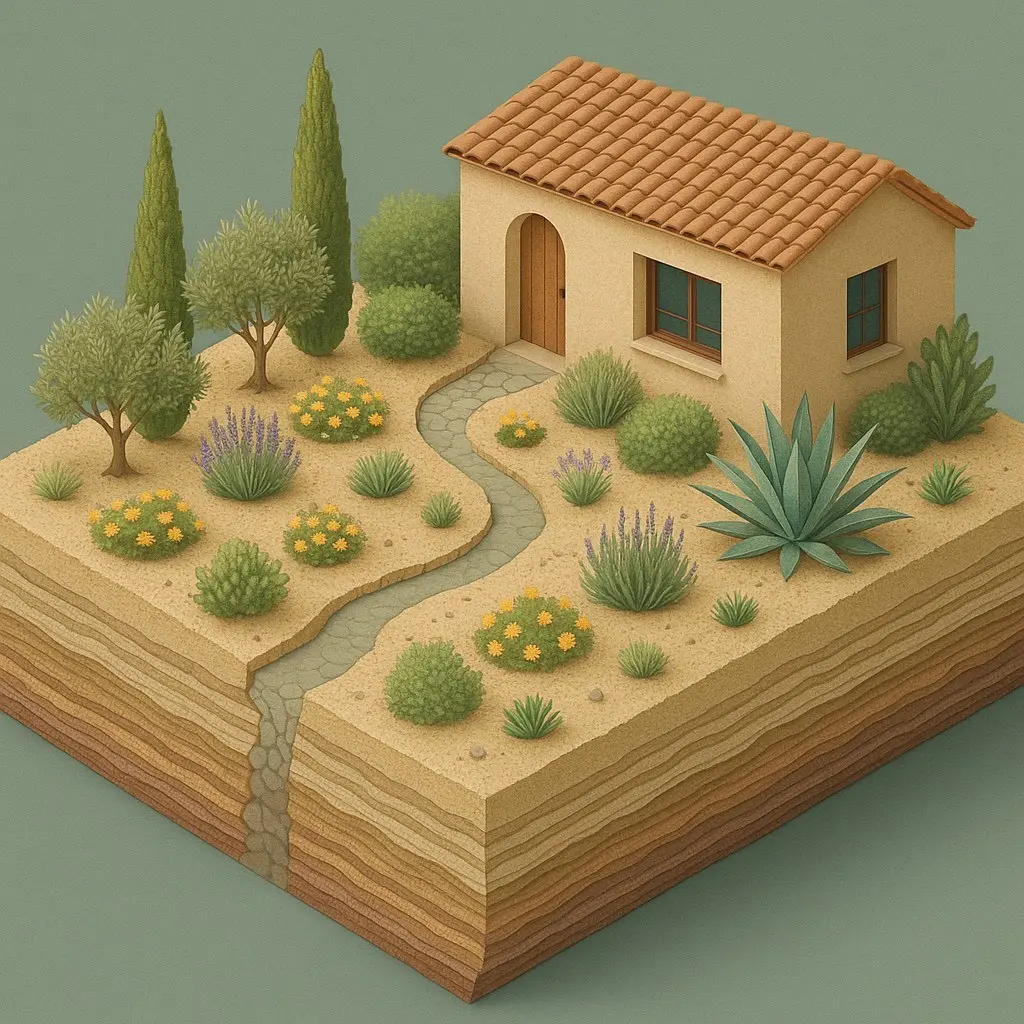Xeriscaping, drought-tolerant plants
Summer in Greece. The sun scorches, the soil cracks, and your newly planted flowers wither before they even bloom. If you’ve ever tried to create a beautiful garden in a Mediterranean climate, you surelyknow the feeling. Drought, high temperatures, and water scarcity make plant care a challenge and often a failure. But there is a solution, and it’s called xeriscaping.
Most gardens in Greece face a common problem: “lack of water.” No matter how impressive the plants we choose may be, they often can’t withstand the dry summer. The result? Burnt vegetation, increased watering costs, and disappointment.
In this article, we’ll explore why xeriscaping a smart planting approach based on the principles of drought resistance is the ideal solution for Mediterranean gardens.

1. Why is xeriscaping an ideal choice for dry Mediterranean climates?
Xeriscaping is a type of garden design that uses drought-tolerant plants, native species, and techniques that reduce the need for watering.
Mediterranean climates like Greece, summer drought is common, and water conservation becomes essential.
Xeriscaping fits perfectly in these conditions because it takes advantage of the natural resilience of local plants and reduces the need for intensive care.
Example:
Let’s say you have a garden in Crete or Attica. If you plant roses, water-loving plants, or a lawn, you’ll need to water daily especially in summer.
The cost will be high, and the environment will suffer. In contrast, with xeriscaping, you use plants like:
- Lavender (Lavandula)
- Rosemary (Rosmarinus officinalis)
- Wild thyme (Thymus)
- Mani ivy
- Wild olive or mastic tree
- Rocks, gravel, and natural surfaces instead of lawn
These plants tolerate heat, require minimal water, and create a visually appealing, low-maintenance, and eco-friendly garden.
2. What is xeriscaping and why should I choose it for my garden in Greece?
Xeriscaping is a landscaping method officially developed and introduced in 1981 by Denver Water, the municipal water utility of Denver, Colorado, USA.
Denver Water collaborated with local gardeners, agronomists, and landscape architects. The term “xeriscape” was coined by Nolan Dosken, an employee of the utility, and comes from the Grek word “xeros” (meaning “dry”) + “landscape.”
In 1981, in response to a severe drought that affected Colorado in the 1970s and the growing need for an ecological and water-efficient approach to garden andlandscape design, xeriscaping was born.
The idea behind xeriscaping was not just to save water, but to:
- Raise public awareness about the smart use of natural resources
- Showcase the beauty of a dry yet aesthetically pleasing landscape
- Create a set of principles for both professional landscapers and everyday citizens
The 7 original principles of xeriscaping:
- Design based on local climate and conditions
- Selection of appropriate, drought-tolerant plants
- Efficient irrigation systems
- Soil improvement (where needed)
- Use of mulch (organic ground covers)
- Effective maintenance
- Reduction of lawn areas
Why xeriscaping is ideal for Greece In the 1990s, xeriscaping spread to many arid U.S. states (California, Arizona, Nevada) and today it is a global approach to sustainable landscape management—especially in regions with limited water resources, like Greece.
Greece has a Mediterranean climate, which means:
- Hot summers with minimal rainfall
- Limited water resources
- Increasing periods of drought and irrigation restrictions
Example:
Instead of planting a lawn that requires daily watering and mowing, you can create a xeriscape garden with:
- Gravel ground cover
- Native shrubs and Mediterranean aromatic plants
- Aloes, cacti, olive trees, and mastic trees
- A drip irrigation system only for young plants and trees
3. What are the advantages of xeriscaping for areas with dry summers?
Xeriscaping refers to planting and landscaping techniques that reduce or even eliminate the need for irrigation.
A “dry summer” means temperatures above 30°C (86°F), very little rainfall, and frequent periods of drought.
Here are the main benefits of xeriscaping in such conditions:
- Water conservation the most important advantage: it uses drought-tolerant plants, reducing water consumption by up to 70%.
- Low maintenance costs less need for watering, mowing, fertilizing, and pest control— leading to lower operating costs and less labor.
- Resilience to heatwaves and drought Plants are selected for their ability to thrive in high temperatures and poor soils.
- Long-term sustainability the garden becomes more stable, self-sustaining, and doesn’t collapse during drought periods.
- Harmony with the landscape and microclimate It creates an ecologically intelligent space that supports local biodiversity (bees, butterflies, birds).
- Aesthetic appeal with a natural character Instead of lawn, materials like stone, gravel, wood, and naturally shaped plants are used giving the space unique character.
- Reduced fire risk with proper design, a dry garden can reduce the density of flammable vegetation.
4. How does xeriscaping help address water scarcity in the garden?
This method helps tackle water shortages because it’s based on plants and techniques that work with the climate not against it. Instead of relying on constant watering, xeriscaping creates a garden adapted to natural rainfall, optimizing soil moisture.
Here’s how it specifically reduces the need for water:
- Uses drought-resistant plants
- Strategically plans plant placement
- Promotes the use of mulch (organic ground cover)
- Avoids water-intensive lawns
- Uses smart irrigation systems
- Harvests and utilizes rainwater
In a world where water is becoming increasingly precious, xeriscaping is not just a trend it’s a necessity for modern gardens, especially in Greece. With respect for the local climate and smart planting choices, you can create a beautiful, resilient, and sustainable space without waste.
If you’re planning your garden or want to transform it, start with small steps: a few drought- tolerant plants, ground cover and rainwater harvesting. The first step toward an eco-friendly and intelligent garden might be simpler than you think.
The garden of tomorrow begins with the decisions you make today.
If you need guidance or personalized xeriscaping suggestions for your space, get in touch with us. We’re here to help with ideas, designs, and sustainable solutions for every microclimate and need.

As professionals, we bring nature to the forefront with sustainable landscapes inspired by the natural beauty of Crete. We select native, drought-resistant plants, creating spaces that not only respect the environment but also enhance natural growth. From the beginning, our company was built on a philosophy that harmonizes with the land designing landscapes that showcase the authenticity of the Mediterranean.
Wer don’t just design landscapes we revive Crte’s ecosystem, creating sustainable spaces that honor the land and its history.






